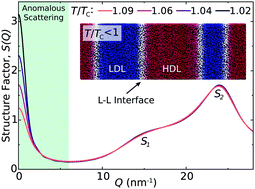Fluctuations near the liquid–liquid transition in a model of silica
Abstract
We perform large-scale molecular dynamics (MD) simulations of systems with up to 216 000 atoms to study the low-temperature behavior of the mWAC model of silica. Recent studies show that mWAC exhibits a liquid–liquid phase transition (LLPT), similar to the one hypothesized to occur in deeply supercooled water. Characterization of mWAC's small-angle scattering behavior reveals an anomalous increase in fluctuations in density and local tetrahedral order in the liquid upon cooling. Moreover, the static correlation length computed from the anomalous scattering component exhibits power-law growth as temperature decreases and appears to diverge near 3300 K. These observations are consistent with previous studies indicating the existence of a liquid–liquid critical point near this temperature. Finally, we use MD to thermally quench systems ranging from 4500 to 432 000 atoms in size into the predicted region of liquid–liquid coexistence. Spontaneous liquid–liquid separation is observed in each system following the quench, demonstrating that this behavior is not strongly influenced by finite-size effects. These findings parallel those recently reported for the ST2 model of water near its LLPT, suggesting common signatures that may be useful for identifying similar transitions in other systems.

- This article is part of the themed collection: 2018 PCCP HOT Articles


 Please wait while we load your content...
Please wait while we load your content...